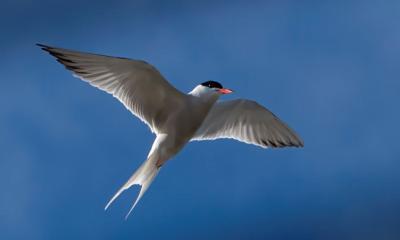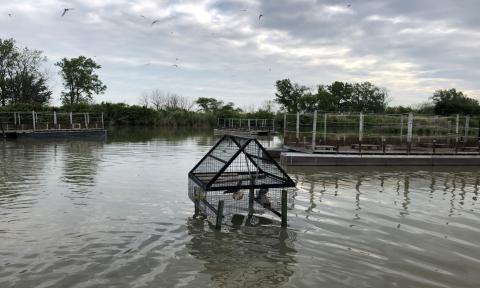As many as 5,000 breeding pairs of common terns (Sterna hirundo) once nested on the sand- and gravel-covered islands and shorelines of western Lake Erie in Ohio. Over the last several decades, though, their populations there and in other Great Lakes states have been declining due to habitat loss, competition for nest sites, predation, and human disturbance. State-listed as endangered since 1974, today their numbers hover around 200 pairs.
The Ohio Division of Wildlife initiated a restoration program for common terns in 1994 on the Ottawa National Wildlife Refuge and at the Pipe Creek Wildlife Area. Breeding birds successfully established a colony in the area, but nesting success was initially low due to predators such as racoons, gulls, great horned owls, and fox snakes. To minimize predation and provide additional habitat, the Division shifted to using artificial nesting platforms (repurposed pontoon boats covered in gravel), but predators continue to target the platforms.
To minimize predation threats to Ohio’s breeding population of common terns, the GLRI and the Ohio Division of Wildlife joined forces with the U.S. Department of Agriculture Wildlife Services. Wildlife Services monitors predators at the tern nesting colonies just prior to nesting until the chicks fledge. Biologists conduct nocturnal surveys to detect the presence of potential predation threats and attach cellular cameras to the nest platforms, allowing real-time monitoring.
Wildlife Services’ direct control activities are currently focused on great horned owls, the most frequent predator of common tern chicks. The preferred management method is to capture and relocate owls far enough from the tern colonies that they do not return during the nesting season. Wildlife Services also uses exclusion techniques (such as barriers and fences) to deter other predators such as mink, raccoon, and fox snakes.
Thanks to these efforts to minimize predation, the number of common tern breeding pairs in Ohio has been at or near the Division of Wildlife’s restoration goal of 200 pairs for the last seven years. Chick production at the colonies has remained variable, however, depending on the activity of predators. Dedicated wildlife damage management efforts like this one, and collaborative partnerships between state and federal agencies, are important to ensuring the continued existence of populations of this vulnerable species.
This post is based on a longer article titled “Conserving the Great Lakes’ (Not So) Common Tern” published in the July/August 2023 issue of The Wildlife Society’s The Wildlife Professional.



